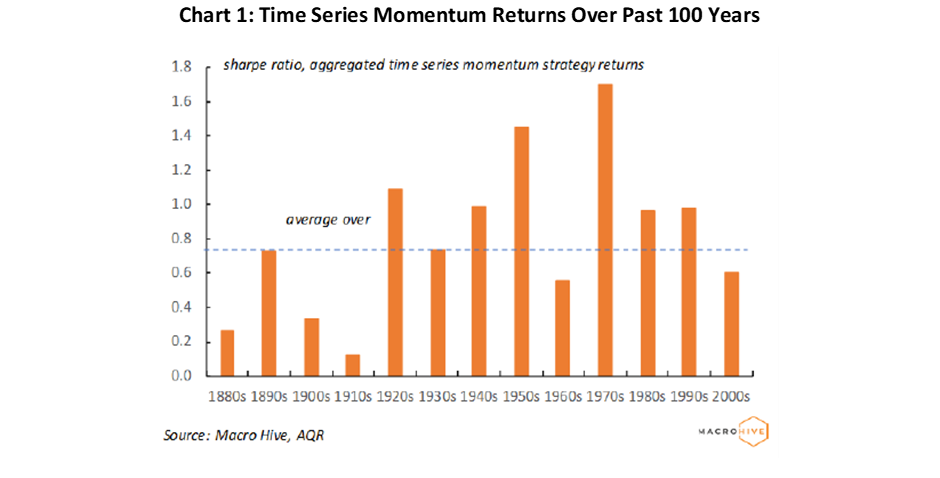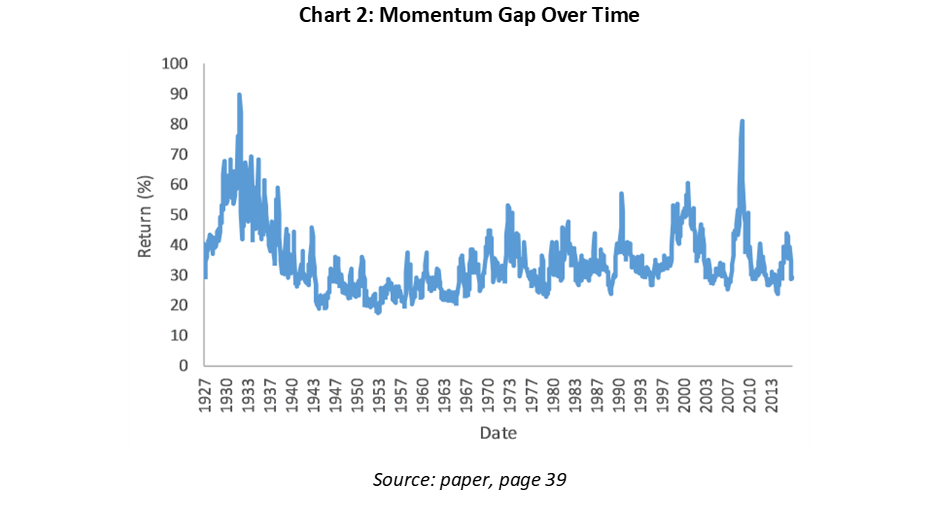

Summary
- A new paper in the highly rated Review of Financial Studies journal explains how momentum profits are strongly linked to the performance of winners and losers during the formation period.
- Specifically, the smaller the difference between the cumulative returns of winners and losers during the formation period, the larger the cross-sectional momentum profits will be.
- Market reactions to news drive these momentum profits. In periods when markets have underreacted, due to conservatism or inattention, momentum profits should be larger.
Introduction
Momentum strategies are popular. They are so popular that the first paper to systematically document their profitability is cited over 13,000 times on Google Scholar – placing it in the top 100 papers of all time, across all fields.
Their profitability has made both cross-sectional and time series momentum strategies some of the most common types of trading models used by investors. They are also popular among researchers, who have sought to explain this pricing anomaly.
The Review of Financial Studies recently published one such paper. It asks, can we predict a momentum strategy’s profitability during the portfolio’s formation period – the period when winners and losers are assessed? We can. Here are the main findings:
- The gap between the cumulative returns of winners and losers over the formation period, the ‘momentum gap’, is negatively associated with momentum profits.
- Neither risk nor arbitraging forces can explain this association. Instead, it is linked to stock-level mispricing created by market reactions to news.
- Lastly, the momentum gap can predict momentum crashes. To avoid the worst of these, the author suggests only investing when the momentum gap is below the 80th percentile.
The Allure of Momentum
What makes momentum strategies so popular is the allure of exploiting past market information to obtain positive future returns. The efficient markets hypothesis says such exploitation should be impossible. Yet researchers have found that the results of Narasimhan Jegadeesh and Sheridan Titman’s seminal paper of 1993[1] hold across developed markets, emerging markets, industries, asset classes and over time (Chart 1).

So, what makes momentum profitable? In short, there are two schools of thought. The first says risk. It contends past winners are riskier, making the profitability of momentum a compensation for risk. The second school argues profits arise from inherent biases that are well-documented in psychology literature.
Arguably, the behavioural strand has so far been more successful at rationalising momentum profitability. For example, researchers have found that profits are generally higher during boom periods and that investor overconfidence can predict momentum payoffs. Limits to arbitraging are another suggestion, where, for example, the profitability of momentum strategies declines with size and analyst coverage.
Data and Methodology
Back to the paper. The author collects US data on stock returns from the Centre for Research in Security Prices (CRSP) and book values of equity from Compustat, running from 1926 to 2016. They also construct a second sample to test whether the results hold across countries – it includes market data on 21 developed-market countries from 1989 to 2013.
The momentum strategy is standard.[2] At the beginning of each month, sort all stocks listed on the NYSE, AMEZ, and NASDAQ into 10 deciles based on their cumulative returns over the formation period (2-12 months before that month). The momentum strategy then goes long a value-weighted portfolio of stocks that have the highest cumulative returns over the formation period (winners) and sells those with the lowest (losers).
The author also breaks the strategy into a long leg and a short leg. The long leg buys past winners and sells the market portfolio, and the short leg buys the market portfolio and sells past losers. All the returns are in logs, and the dependent variable is simple returns.
The paper’s most important concept is what the author calls the ‘momentum gap’. Simply put, it is the difference between the 90th and 10th percentiles of the distribution of cumulative stock returns during the formation period. This measure effectively captures the momentum portfolio’s hypothetical performance before portfolio formation.
The Momentum Gap as a Predictor
The question the author asks is simple. Can the momentum gap predict future momentum profits after accounting for other profit-affecting factors such as liquidity, volatility and market returns? The answer is yes – the gap predicts the returns of the above momentum strategy, including the returns to both the long and short legs. Importantly, the prediction also holds in 20 of the 21 countries the author covers.
On the details, going long in the stocks with the highest cumulative returns (top 10th percentile) and short in the worst-performing stocks (bottom 10th percentile) earns large alphas of 2.18% per month when the performance gap between the two groups during the formation period ranks in the bottom quintile. This drops to just 0.04% when the gap is in the top quintile. In academic lingo, a one standard deviation increase in the momentum gap is associated with a 1.25% decrease in the monthly adjusted returns to the momentum strategy.
The Driver of Momentum Profitability
In essence, the author finds little evidence that risk or the momentum trade’s crowdedness can explain momentum profits. They also show the momentum gap predicts momentum profits among difficult-to-arbitrage stocks as well as it does among easy-to-arbitrage stocks, which rules out arbitrage.
So, the most cited drivers of momentum profitability do not apply here. But what can explain the negative relation between the momentum gap and subsequent momentum profits? The author firmly believes the mispricing that leads to momentum profitability comes from the market’s reaction to certain fundamental news.
Intuitively, a small momentum gap would be typical of a market that has underreacted, for example, due to conservatism or inaction. Conversely, a large gap could signal the market has overreacted due to overconfidence. In both cases, the momentum gap would negatively forecast profits of the winner-minus-loser portfolio as prices revert to their fundamentals.
Building a Strategy That Eliminates Large Downside Risks
Momentum strategies are not immune to losses. In 2001, Jegadeesh and Titman showed that while a winner-minus-loser portfolio earns significant positive returns in year one, returns in years 2-5 are negative. Other studies have shown how occasional extreme crashes characterise momentum strategies.
Interestingly, the momentum gap appears to predict these extreme crashes. We can see this in the peaks in the momentum gap around past crashes, e.g., 1932 and 2009 (Chart 2). Empirically, the author finds that a one-unit increase in the momentum gap comes with a 9-11.5% increase in the odds of the following month’s momentum return being 10-20% lower.

The author believes large reversals in momentum profitability are likely due to the overreaction during the portfolio formation period, rather than the crowdedness of the trading strategy. To avoid the downside risks of crashes, he proposes the following strategy: ‘take a position in the momentum portfolio at the beginning of the month unless the momentum gap is ranked in the top quintile’. In other words, invest only when the momentum gap is below the 80th percentile. This yields a higher Sharpe ratio than the unconditional momentum strategy.
Bottom Line
The paper could help you augment your momentum model. My interpretation is as follows:
First, for a cross-sectional momentum strategy, rank the cumulative returns of all the stocks listed in the index of choice during the selected formation period (which could be 3-12 months). Next, calculate the difference between the return performance of the top 10th percentile and bottom 10th percentile stocks during this period. Then, if this gap is large relative to recent history (i.e., in the top 20th percentile), do not invest. Otherwise, take a position in the formed momentum portfolio.
Citation
Huang, S., (2021), The Momentum Gap and Return Predictability, The Review of Financial Studies, https://doi.org/10.1093/rfs/hhab093
-
Jegadeesh and Titman (1993) found that buying stocks with high returns over the previous 3-12 months, and selling those with poor returns, earns profits of about 1% per month for the following year. This finding still held eight years later in their 2001 update, but profits became negative between two and five years. ↑
-
For more information on the nuts and bolts of momentum strategies in general, read Bilal’s piece. ↑
Sam van de Schootbrugge is a Macro Research Analyst at Macro Hive, currently completing his PhD in international finance. He has a master’s degree in economic research from the University of Cambridge and has worked in research roles for over 3 years in both the public and private sector.
